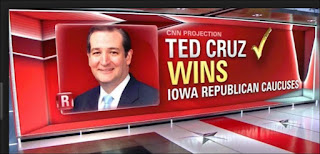Probing for Clues in the Iowa Caucus Numbers
 |
| Screenshot CNN TV Report |
Will Donald Trump fail once again to receive the percentage he's getting in polls? Will Marco Rubio build on his close third-place Iowa finish to overshadow rivals Jeb Bush, John Kasich and Chris Christie, who have been rivaling him in New Hampshire polls?
In a state where evangelical Protestants make up only 22 percent of primary voters, will Cruz fail to replicate what he got in Iowa (where 64 percent of GOP primary voters identify as evangelical Protestants)? Will Hillary Clinton lose as badly to Bernie Sanders as current polling indicates?
The most plausible answer to each of these questions is yes. But presidential nomination politics is full of surprises. We'll have answers in a few days.
But in the Iowa results, we already have answers to some tantalizing questions that have been hanging over the political landscape for months. The most tantalizing of which concern the one thing polls aren't good at projecting: turnout.
The vote counters from Microsoft report that 186,000 Iowans voted in the Republican caucuses. Iowa Democratic officials say that 171,000 votes were cast in the Democratic caucuses (where the official results are scored in state convention delegate equivalents).
Let's put that in historic perspective. In 2012 Republican turnout was 122,000. In 2008, the last time both parties had nomination contests, Republican turnout was 119,000, and Democratic turnout 220,000. In 2004 Democratic turnout was 124,000.
In other words, Democratic turnout doubled between 2004 and 2008 -- a good indicator of the party's increased strength during the second George W. Bush term. It presumably also reflected genuine enthusiasm for candidates Barack Obama, Hillary Clinton and (remember him?) John Edwards. The fact that about twice as many Democrats as Republicans turned out was a good indicator of the Democratic victories in Iowa and the nation that November.
The balance of enthusiasm seems to tilt the other way this year. Republican turnout wasn't hugely larger than Democratic; it amounted to 52 percent of the two-party turnout in a politically marginal state. But the trend line is positive for Republicans (turnout up 54 percent from 2012) and negative for Democrats (turnout was down 22 percent form 2008).
That's in line with another indicator -- the viewership of the parties' presidential debates. Between 11 million and 24 million people have watched the seven debates -- all significantly above the party's previous record of 8 million. Viewership averaged 16.6 million. Democratic viewership was between 8 million and 16 million, averaging 10.6 million, the party's previous record. An uptick for Democrats, a surge upward for Republicans.
One theory is that the Republican increase was due to the celebrity appeal of Donald Trump. Partly but not entirely, I conclude from extrapolations (necessarily somewhat imprecise) from Iowa entrance polls. Republicans had 84,000 first-time caucus-goers, more than the 75,000 Democrats. Trump did lead with 25,000 first-timers, but 19,000 voted for Ted Cruz and 18,000 for Marco Rubio. Trump attracted newcomers but so did his main rivals.
Some 119,000 of Republicans were evangelical Protestants, up from 69,000 in 2012. This tends to support Cruz's argument that he can bring out conservative previous non-voters. But only up to a point: Cruz got 39,000 votes from evangelicals, Trump and Rubio 25,000 each. Other candidates and other factors may be drawing them in too.
One big demographic split in 2012 Republican primaries was between college-graduate and non-college voters. This split was visible but not stark in Iowa. Cruz and Trump got about 55 percent of their votes from non-college-grads; Rubio got about 60 percent of his from college-grads.
Young people continue to be reluctant to participate in Iowa's protracted caucus process: Only 15 percent of caucus-goers were under 30. But though most voted Democratic, only 4,000 voted for Hillary Clinton, the same as Trump and less than Rubio's 5,000 and Cruz's 6,000.
In the 2008 Democratic caucuses, 28,000 young Iowans voted for Obama. That was a harbinger of his November 66-to-32 percent win among millennials, which accounted for almost all his popular vote margin. Clinton seems incapable of duplicating that, or even the reduced millennial percentages Obama and Democrats have won since 2008.
Clinton runs much stronger among older Democrats: 81 percent of her caucus votes came from those over 45. But Iowans of this age group voted significantly more often in Republican than Democratic caucuses.
So there's some modest good news for Republicans and modest bad news for Democrats in the Iowa numbers. On to New Hampshire.
---------------------
Michael Barone, senior political analyst for The Washington Examiner, resident fellow at the American Enterprise Institute, Fox News Channel contributor, co-author of The Almanac of American Politics, and contributed this article to Townhall.com a source for conservative news and political commentary and analysis.
 Tags: Probing for Clues, Iowa Caucus Numbers, Michael Barone, Townhall.com To share or post to your site, click on "Post Link". Please mention / link to the ARRA News Service. and "Like" Facebook Page - Thanks!
Tags: Probing for Clues, Iowa Caucus Numbers, Michael Barone, Townhall.com To share or post to your site, click on "Post Link". Please mention / link to the ARRA News Service. and "Like" Facebook Page - Thanks!
Posted by Bill Smith at 2:00 PM - Post Link




0 Comments:
Post a Comment
<< Home